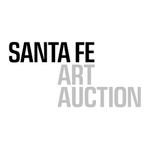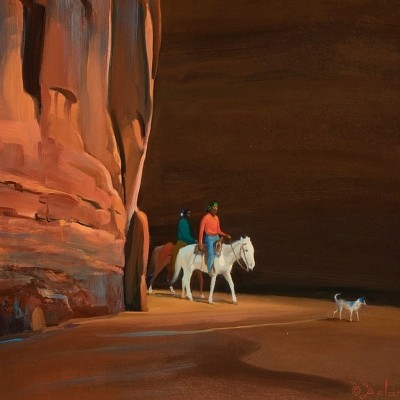Edward S. Curtis, The North American Indian - Volume I and Portfolio I, 1907
About Seller
932 Railfan Road
Santa Fe, NM 87505
United States
Boasting the third-largest art market in the United States, Santa Fe has long been a destination for new and seasoned collectors. Located in the heart of the city’s historic downtown, and organized in conjunction with the Gerald Peters Gallery, the Santa Fe Art Auction is the Southwest’s premier ann...Read more
Two ways to bid:
- Leave a max absentee bid and the platform will bid on your behalf up to your maximum bid during the live auction.
- Bid live during the auction and your bids will be submitted real-time to the auctioneer.
Bid Increments
| Price | Bid Increment |
|---|---|
| $0 | $100 |
| $2,000 | $250 |
| $5,000 | $500 |
| $10,000 | $1,000 |
| $20,000 | $2,500 |
| $50,000 | $5,000 |
| $100,000 | $10,000 |
About Auction
Nov 6, 2021
The Santa Fe Art Auction is delighted to present the 29th Signature Live Auction – the pinnacle of our calendar year. This year it brings together the very best of our diverse sale categories, including Native American, Spanish Colonial, Prints and Works on Paper, and fine American art. Santa Fe Art Auction info@santafeartauction.com
- Lot Description
Edward S. Curtis
(1868 - 1952)
The North American Indian - Volume I and Portfolio I, 1907
Volume and portfolio on Japanese Gampi tissue etching stockFeaturing the Southwestern tribes of the Apache, Jicarilla and Navaho.Portfolio I
39 photogravures on Japanese Gampi tissue etching stock with original Van Gelder overmatssigned in plate below image: E. S. Curtis23 x 19 in. / prints 18 x 22 in.
Volume I79 photogravures on Japanese Gampi tissue etching stock including 4 hand-colored printssigned on page xvii: Edward S. Curtis 190712 1/2 x 9 1/2 in. / prints approx. 7 1/2 x 5 1/2 in.
Offered here is a rare pairing of Portfolio and Volume I from Edward Curtis’ The North American Indian. Photographed between 1903 and 1907, and featuring the Southwestern tribes of the Navaho and Apache, many of Curtis’ most recognizable images are found here. The Volume of small prints include The Jicarilla and Apache Maiden, and the many portraits of ceremonial masked individuals. The Portfolio of large prints include The Vanishing Race, Geronimo, An Apache Babe, Chief Garfield and the iconic Cañon de Chelly, designated a National Monument in 1931 and one of the Navaho’s most sacred places. Most of The North American Indian sets books and portfolios are are owned by institutions, so very rarely come to auction. This pairing offers a rare and unusual opportunity to acquire the first volume and portfolio from Curtis landmark publication.
PORTFOLIO ILIMITED EDITION: This Portfolio is from set #96, printed on handmade Japanese gampi tissue paper, quarto, original ¾ brown crushed levant by H. Blackwell of Boston, over beige linen-covered boards, original gilt lettered, with photogravure plates by John Andrew & Son of Boston after photographs by Edward S. Curtis, edited by Frederick Webb Hodge, Chief of the Bureau of American Ethnology, field research conducted under the patronage of J. Pierpont Morgan.
PORTFOLIO: 39 large format photogravures, including a List of Plates reference that is hand letterpress printed on hand-made paper. Loose bound in a hand-made, 3-flap portfolio.
ADDITIONAL: This example is from set #96, which descends from William Henry Moore (1847-1923) and his brother James Hobart Moore (1851-1916) to the Moore Memorial Library. The brothers founded the library in their boyhood home of Greene, New York, in 1903, in honor of their mother. While the Moore’s were not as well known as the Carnegies, Morgan’s and Harriman’s, the family operated in the same social milieu. They were friends of J.P. Morgan, the visionary industrialist, and collector, who first sponsored Curtis’ comprehensive pictoral chronicle of native life, and next to Morgan, successfully exploited the financial possibilities of industrial mergers in the United States.
Portfolio Provenance:Edward S. Curtis StudioWilliam Henry MooreThe Moore Memorial LibraryThe Christopher G. Cardozo Collection, 1998
Exhibited: The following prints from this portfolio have been included in national and international exhibitions:Cañon de Chelly, Plate 28The Blanket Weaver, Plate 34Sacred Legacy: Edward S. Curtis and the North American Indian (176 print exhibit), 2000Edward S. Curtis: 100 Masterworks, 2016The Medicine Man - Hastobîga, Plate 35Sacred Legacy: Edward S. Curtis and the North American Indian (176 print exhibit), 2000
VOLUME I LIMITED EDITION: This volume is numbered 470, printed on handmade Japanese gampi tissue paper, quarto, top edges gilt, original ¾ brown crushed levant by H. Blackwell of Boston, over beige linen-covered boards, original gilt lettered, raised paneled spine, with photogravure plates by John Andrew & Son of Boston after photographs by Edward S. Curtis, edited by Frederick Webb Hodge, Chief of the Bureau of American Ethnology, field research conducted under the patronage of J. Pierpont Morgan.
TEXT VOLUMES: 79 photogravures, including 4 hand-colored prints. Over 180 pages of text and transcriptions of language and music. Hand letterpress printed on hand-made paper. Hand-bound.
ADDITIONAL: This example is from set #470, which descends from original subscriber, the Estate of Lord Glenconner, a seat of one of the most colorful families in England’s aristocracy, and one of the most beautiful mansions in Scotland.
Volume Provenance:Edward S. Curtis StudioLord Glenconner Estate, LondonPrivate Collection(s)The Christopher G. Cardozo Collection, 2006Portfolio: This original Portfolio of prints is in excellent condition overall. The photogravures are rich and saturated, with luminous highlights and fine details, which the gampi etching stock is known for. The original Van Gelder overmats are crisp and bright. The tissue prints and Van Gelder overmats have been conserved. The prints have been backed, or lined, with another piece of gampi tissue paper. This has the effect of laterally stabilizing the print so that it is less susceptible to contraction and expansion from environmental conditions, which can cause condition issues with prints that are not backed. Most prints have minor to moderate, soft rippling, which is primarily visible in bright, raking light, and is somewhat typical for Curtis’ photogravures on the Japanese gampi etching stock. Externally, the folio is in excellent condition overall. The covers, corners, and spine are excellent, with typical, minor, scattered nicks and scuffs to the leather and buckram, and minor wear at the corners. Most of the silk ties have been detached, with a couple being partially intact.Condition
Volume: This original volume is in good to very good to excellent condition overall. Internally, the pages are crisp and bright overall. The photogravures are rich and saturated, with fine highlights and details, including four hand-colored plates. The “Bound by H. Blackwell” stamp is present at the upper left corner of the flyleaf. The silk bookmark is present. There is minor to pronounced, scattered foxing throughout. Many of the deckled fore-edges show foxing and moderate darkening. Some of the photogravures show minor wrinkling at the print corners, with some having wrinkles in the image area, which are primarily visible in strong, raking light. Externally, the top-edge gilding is excellent, with a couple of scattered scuffs and nicks. The binding is strong and intact. There is a minor split at the upper right spine corner, visible upon close inspection. The front cover, corners, and spine are very good, with minor, scattered nicks and scuffs to the leather and buckram, and minor wear at the corners.
Overall, these are very good examples of work from Curtis' seminal set, with exceptional provenance and beautifully rich plates.
The condition reports for the lots offered by Santa Fe Art Auction (SFAA) are provided as a courtesy and convenience for potential buyers. The reports are not intended to nor do they substitute for physical examination by a buyer or the buyer's advisors. The condition reports are prepared by SFAA staff members who are not art conservators or restorers, nor do they possess the qualifications needed for comprehensive evaluation. Each condition report is an opinion of the staff member and should not be treated as a statement of fact. The absence of a condition report does not imply anything as to the condition of a particular lot. Buyers are reminded that the limited warranties are set forth in the Terms and Conditions of Sale and do not extend to condition. Each lot is sold as-is. - Shipping Info
-
The Santa Fe Art Auction may, in its discretion and at a Buyer’s request, pack and ship items as directed by the Buyer. In such event, Buyer agrees to the following conditions:
- All such packing, handling and shipping is at the sole risk of the Buyer and the Santa Fe Art Auction shall have no liability for any loss or damage to such items, and
- Buyer shall pay all related expenses in advance. Buyer should allow four to six weeks for shipping from the date of the auction.
SANTA FE ART AUCTION IS PLEASED TO PRESENT THE FOLLOWING SHIPPING OPTIONS. PURCHASES SHALL NOT BE RELEASED UNTIL PAYMENT IS RECEIVED IN FULL.
_____ I would like to pick up my artworks from Santa Fe Art Auction.
Arrangements for pick up must be made within 2 weeks post sale via email or telephone. I understand that I may be liable for New Mexico Sales tax.
_____ I would like my artwork to be released to a third-party shipping company (selected below).
If I select this method of shipping, I understand I must sign and deliver to the Santa Fe Art Auction the Release and Insurance Waiver below.
The UPS Store
3201-C Zafarano Drive
Santa Fe, NM 87505
Telephone: 505-438-2427
store6324@theupsstore.com
PAKMAIL
369 Montezuma Avenue
Santa Fe, NM 87501
Telephone: 505-989-7380
Website: weshipsantafe.com.
Art Handlers LTD
1570 Pacheco St. Suite A-1
Santa Fe, NM 87505
Telephone: 505-982-0228
Other:
Company Name / Authorized Agent _____________________________
Address __________________________
Telephone __________________
E-mail ____________________
RELEASE & INSURANCE WAIVER
- I, ________________ ("Purchaser") have paid for and own the following art: Lot (s) # ________________ (hereinafter "Work(s) of Art").
- I want my Work(s) of Art shipped via this shipper: ___________ ("Shipper"). Santa Fe Art Auction ("SFAA") is hereby directed to release the Work(s) of Art to Shipper at SFAA's location in Santa Fe, New Mexico on a date stated in writing to SFAA by Purchaser.
- SFAA shall be released and discharged from any and all duties of care owing from SFAA to Purchaser and Purchaser hereby unconditionally waives any and all claims against SFAA.
- Purchaser acknowledges and agrees that SFAA, and any of their agents do not carry specific insurance for the Work(s) of Art listed. The Purchaser has agreed to arrange or cause to be arranged the insurance for the transit and handling of the property. SFAA shall bear no responsibility for the adequacy of the Purchaser's insurance.
- Upon delivery of the Work (s) of Art to Shipper, and at all times thereafter, Purchaser shall indemnify and hold SFAA harmless from and against any and all claims related to the Work(s) of Art, directly or indirectly, however such claims may arise.
- Purchaser affirms to SFAA that Purchaser has the authority to execute and perform this Release.
__________________________________________________
Buyers Signature Date
ADDENDUM: Request for Frame Removal
** I, _________________________ ("Purchaser") hereby request the following Lot(s) ______________ be removed from the frame by SFAA prior to release to my selected Shipper.
- Such service shall be provided to the Purchaser at a cost of $_____________ per Lot.
- The Purchaser shall hold harmless SFAA for any and all claim(s), for any loss or damage howsoever occurring, irrespective of negligence, including any claim expense or consequential loss while handling, removing from frame or uninstalling.
-
- Buyer's Premium



 EUR
EUR CAD
CAD AUD
AUD GBP
GBP MXN
MXN HKD
HKD CNY
CNY MYR
MYR SEK
SEK SGD
SGD CHF
CHF THB
THB
































